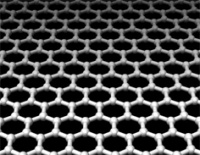Graphene could underpin carbon-based electronics
The Nobel prize-winning inventors of graphene have characterised the properties of an ultra-pure bilayer of the material that could provide a foundation for carbon-based electronics.

It is the latest work from Prof Andre Geim and Prof Kostya Novoselov, based at Manchester University, who after creating the first graphene sheet using scotch tape now wish to speed up progress on potential applications of the material.
Graphene, which is a single-layered sheet of carbon atoms, has excellent electrical conductivity and very low resistance owing to its hexagonal lattice arrangement of atoms.

However, a single graphene sheet actually conducts charge so well that it is difficult to make the current stop. This is a crucial stumbling-block if the material is ever going to be used for microelectronic devices such as transistors that act to control the flow of current to perform tasks and computations.
To achieve this one must be able to create an electronic band gap, or break in electron energy levels, which essentially turns the material into a semiconductor.
‘Bilayer graphene has this very wonderful property in that a [band] gap can be opened in the spectrum if you apply a voltage perpendicular between the two layers,’ said Novoselov. ‘Not that many materials exist where you can control the opening of the band gap by applying an electric field.’
Register now to continue reading
Thanks for visiting The Engineer. You’ve now reached your monthly limit of news stories. Register for free to unlock unlimited access to all of our news coverage, as well as premium content including opinion, in-depth features and special reports.
Benefits of registering
-
In-depth insights and coverage of key emerging trends
-
Unrestricted access to special reports throughout the year
-
Daily technology news delivered straight to your inbox










Water Sector Talent Exodus Could Cripple The Sector
Maybe if things are essential for the running of a country and we want to pay a fair price we should be running these utilities on a not for profit...